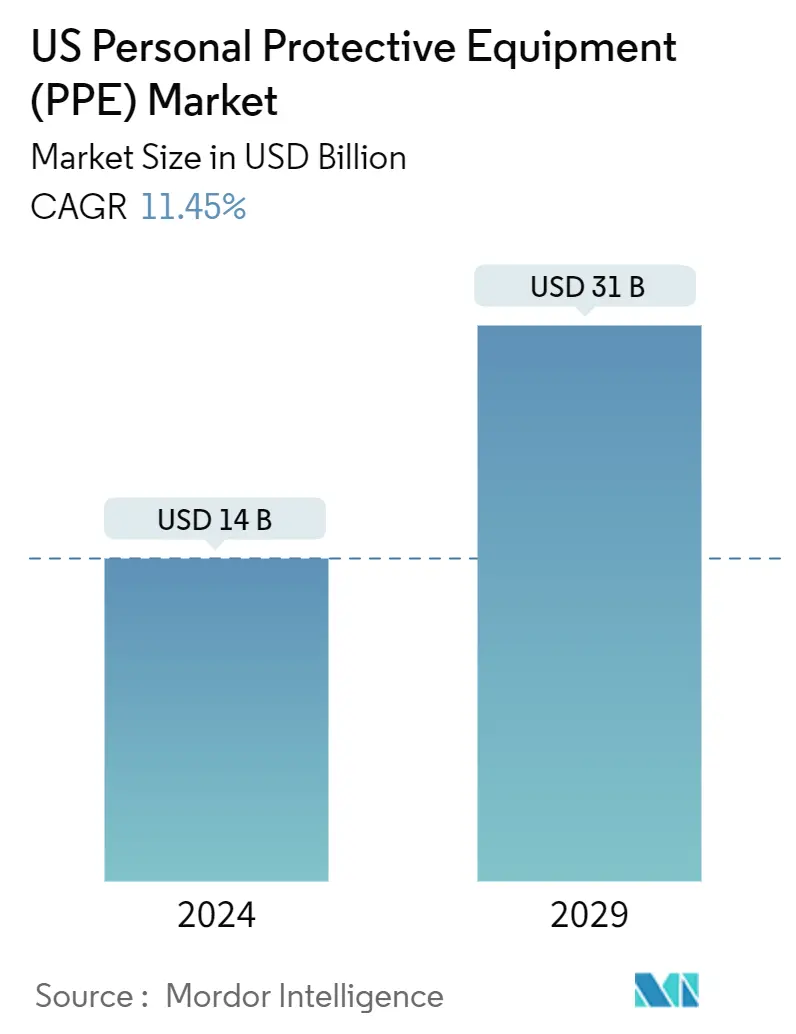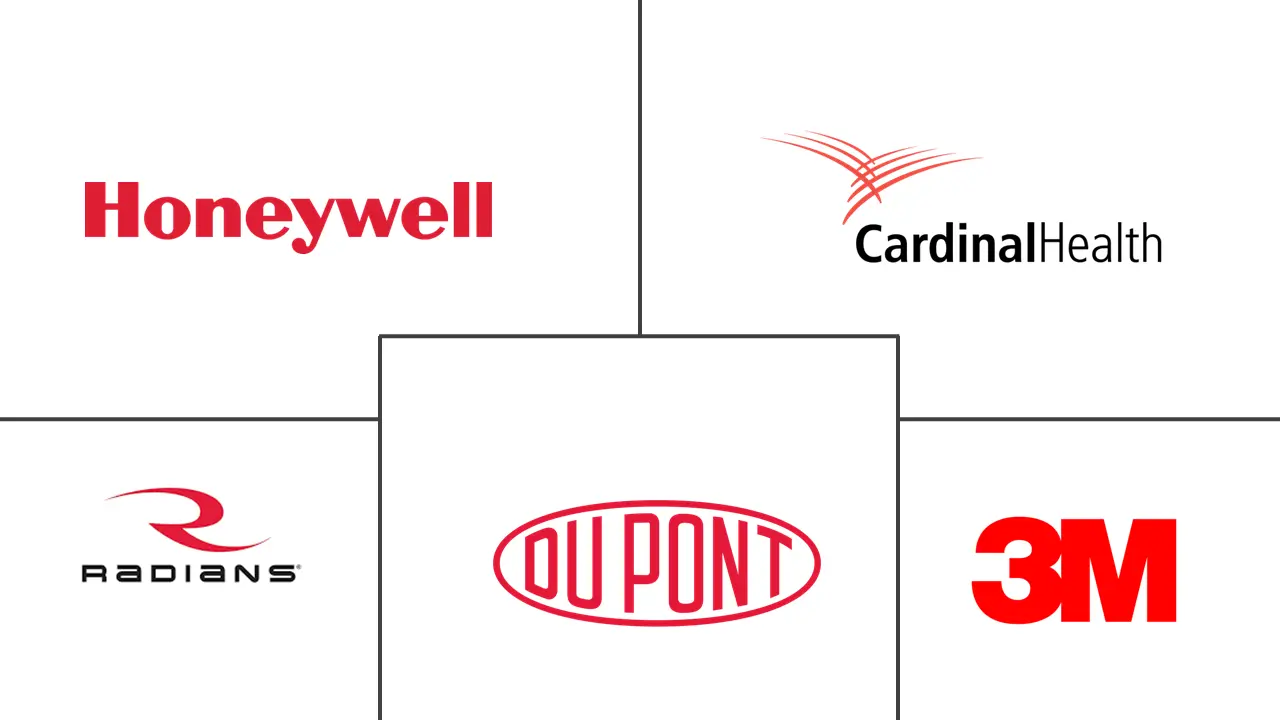Market Size of US Personal Protective Equipment (PPE) Industry

| Study Period | 2019 - 2029 |
| Base Year For Estimation | 2023 |
| Forecast Data Period | 2024 - 2029 |
| Market Size (2024) | USD 14 Billion |
| Market Size (2029) | USD 31 Billion |
| CAGR (2024 - 2029) | 11.45 % |
| Market Concentration | Medium |
Major Players
*Disclaimer: Major Players sorted in no particular order |
US Personal Protective Equipment (PPE) Market Analysis
The US Personal Protective Equipment Market size is estimated at USD 14 billion in 2024, and is expected to reach USD 31 billion by 2029, growing at a CAGR of 11.45% during the forecast period (2024-2029).
Personal protective equipment(PPE) is used to prevent or minimize exposure to different hazards. Various industries, including construction, manufacturing, and chemical, use PPE to protect their workforce from occupational hazards.
- Increasing demand for PPE from the manufacturing and construction industries and rising instances of work-related injuries are among the major factors driving the market's growth. Stringent regulatory mandates in the country by organizations such as OSHA and ANSI also necessitate using PPE in different industries. For instance, as per OSHA's respiratory protection standard 29 CFR 1910.134, many workers are required to wear respirators in various workplaces throughout the United States to protect them against insufficient oxygen environments, harmful dust, fogs, smoke, mists, gases, vapors, and sprays.
- Innovations in design, materials, or manufacturing processes that help to make PPE safer while making it more comfortable and appealing to users also help foster market growth. For instance, safety gloves made of Kevlar are stated to be more resistant to cuts than gloves made from other materials.
- PPE materials, like synthetic polymers and aromatic polyamides, are derived from crude oil. PPE raw-material costs significantly depend on crude oil prices and availability. Thus, the recent volatility in crude oil markets, including substantial price drops, has harmed PPE manufacturing costs.
- The COVID-19 pandemic accelerated the short-term demand for masks, gloves, and other PPE in healthcare. However, the pandemic was not expected to have a significant long-term effect on demand in the market.
US Personal Protective Equipment (PPE) Industry Segmentation
Personal protective equipment or PPE refers to the equipment worn to minimize exposure to hazards that can result in serious workplace injuries and illnesses.
The United States ersonal protective equipment (PPE) market is segmented by product type (hand protection, protective clothing, respiratory protection, protective footwear) and end-user (healthcare, food and beverage, construction, manufacturing, oil & gas, chemical, mining). The market sizes and forecasts are provided in terms of value (USD) for all the above segments.
| By Product Type | |
| Hand Protection | |
| Protective Clothing | |
| Respiratory Protection | |
| Protective Footwear | |
| Other Product Types |
| By End User | |
| Healthcare | |
| Food and Beverage | |
| Construction | |
| Manufacturing | |
| Oil & Gas | |
| Chemical | |
| Mining | |
| Other End-Users |
US Personal Protective Equipment (PPE) Market Size Summary
The United States Personal Protective Equipment (PPE) market is poised for significant growth, driven by increasing demand from industries such as manufacturing and construction, alongside rising work-related injuries. The market is influenced by stringent regulatory requirements from organizations like OSHA and ANSI, which mandate the use of PPE to safeguard workers from various hazards. Innovations in PPE design and materials, such as the use of Kevlar for safety gloves, are enhancing the safety and comfort of protective gear, further propelling market expansion. However, the volatility in crude oil prices, which affects the cost of PPE materials like synthetic polymers, poses challenges to manufacturing costs. The COVID-19 pandemic temporarily boosted demand for PPE in healthcare, but its long-term impact on the market is expected to be minimal.
In the manufacturing sector, which is a significant contributor to the U.S. economy, the need for high-quality PPE is critical to ensure worker safety from respiratory and hand hazards. The prevalence of workplace injuries, particularly in the manufacturing, mining, and agriculture sectors, underscores the importance of effective hand protection solutions. The market is characterized by intense competition, with major vendors like Honeywell International Inc., 3M, and Radians, Inc. leveraging mergers, acquisitions, and partnerships to enhance their market presence. Recent initiatives, such as those by the American Medical Manufacturers Association and collaborations like that between 3M and Guardhat, aim to improve the affordability and connectivity of PPE, indicating a dynamic and evolving market landscape.
US Personal Protective Equipment (PPE) Market Size - Table of Contents
-
1. MARKET INSIGHTS
-
1.1 Market Overview
-
1.2 Industry Attractiveness- Porter's Five Forces Analysis
-
1.2.1 Bargaining Power of Suppliers
-
1.2.2 Bargaining Power of Consumers
-
1.2.3 Threat of New Entrants
-
1.2.4 Threat of Substitutes
-
1.2.5 Intensity of Competitive Rivalry
-
-
1.3 Industry Value Chain Analysis
-
1.4 Impact of COVID-19 on the Market
-
-
2. MARKET SEGMENTATION
-
2.1 By Product Type
-
2.1.1 Hand Protection
-
2.1.2 Protective Clothing
-
2.1.3 Respiratory Protection
-
2.1.4 Protective Footwear
-
2.1.5 Other Product Types
-
-
2.2 By End User
-
2.2.1 Healthcare
-
2.2.2 Food and Beverage
-
2.2.3 Construction
-
2.2.4 Manufacturing
-
2.2.5 Oil & Gas
-
2.2.6 Chemical
-
2.2.7 Mining
-
2.2.8 Other End-Users
-
-
US Personal Protective Equipment (PPE) Market Size FAQs
How big is the US Personal Protective Equipment Market?
The US Personal Protective Equipment Market size is expected to reach USD 15.60 billion in 2025 and grow at a CAGR of 11.45% to reach USD 26.83 billion by 2030.
What is the current US Personal Protective Equipment Market size?
In 2025, the US Personal Protective Equipment Market size is expected to reach USD 15.60 billion.

